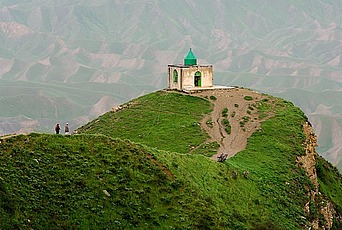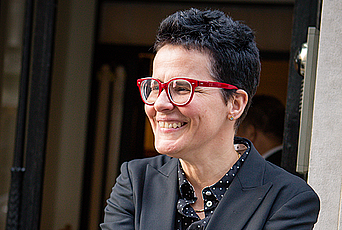Peace and Quiet in Castile
To outsiders, the contentiousness, divisiveness, and downright un-neighborliness evident in the small Spanish town of Deza by the autumn of 1607 might well have seemed a tempest in a teapot. Those living in the newer Upper Neighborhood had been squaring off against the inhabitants of the older, medieval Lower Neighborhood for years, and the conflict appeared to be reaching a climax. Tensions had been building since the 1590s as recriminations, threats, public brawls, armed uprisings, and fiery sermons gave way to lawsuits and backroom political maneuvering that culminated in arrests, torture, murder, and exile. Heady stuff for small-town folk.
In December of that year, following the unexpected death of the town’s feudal lord, his infant son, now Duke of Medinaceli in his own right, formally asserted seigniorial authority. Because of the boy’s youth, a proxy appointed by his grandfather, the powerful Marquis of Velada, stood in during the traditional ceremony of possession in Deza. The official record of that event repeatedly informs us that the whole affair occurred “quietly and peacefully.” But unmentioned is the fact that peace and quiet were strangers in Deza, brimming as it was with social, economic, political, and religious tensions.
Ceremonial occasions, in that age as in our own, articulated ideological aims and made social statements. They were about wielding power and asserting authority, but they were also moments of uncertainty and negotiation. King Philip II of Spain (r. 1556–98), for example, had been forced to modify his plan for entering Valencia before locals allowed it to proceed, and his 1548 entry into Genoa stirred up riots. If a king didn’t always get what he wanted, neither did feudal lords. As Teofilo Ruiz has noted, ceremonies, because they were about the relationship between a people and their lord, could be dynamic and surprising. The message encoded in Deza’s 1607 possession ceremony was something like, “Let there be peace in this town, for the duke is in charge.” But, in politics as in life, when local plans converge with grander schemes, things rarely go as expected.
Deza had boomed during the sixteenth century. Its population spiked, its urban footprint expanded, a magnificent new parish church was constructed, and wealth increased. Local powerbrokers hatched big plans for the town, envisioning Deza as a dominant regional force that would manage its affairs with minimal interference from the duke. Deza’s Moriscos (the descendants of Spanish Muslims baptized en masse in 1502) and Old Christians (who claimed to be free of Muslim or Jewish blood) collaborated in these efforts, pursuing agendas that would further enrich them, benefit their small republica, and bring glory to Spain.
Despite intermittent pressure from inquisitorial and episcopal authorities, Old Christians and Moriscos worked with, for, and alongside one another; they gossiped, formed relationships, and (very occasionally) intermarried. Together, they attended weddings, joined confraternities, worshiped in the church, and, by tradition, sat next to one another as officeholders on the town council, administering justice, overseeing finances, and managing day-to-day affairs.
At the turn of the century, however, as boom turned to bust, an Old Christian faction in Deza became increasingly concerned about the town’s Morisco citizenry. Driven by a complex combination of economic and political interests, fear, inquisitorial activity, and the inflammatory encouragement of a local priest, many Old Christians came to see the Morisco minority as dangerous. And when, in 1600, the Morisco inhabitants of the Upper Neighborhood unilaterally withdrew from the town’s lawsuit against its duke, Old Christians reacted. They secured a legal declaration that, they claimed, forbade Deza’s Moriscos from serving on the town council. Yet, the Moriscos fought back and gained a surprising victory when the royal appellate court found that they had just as much right to hold municipal office as any other citizen and could not be barred merely on account of their ancestry.
Now, the Old Christians’ fears were not entirely irrational. Many of Deza’s Moriscos regarded themselves as Muslims and practiced the “Law of Mohammed,” as it was known, more or less secretly. In an age where religious conviction and loyalty to king were deeply intertwined, this smacked of treason to many observers. Occasionally, Moriscos in Deza voiced eschatological hopes for liberation from Christian rule. A few wanted to take up arms against the state. The arrest, trial, and posthumous conviction of Dezano Román Ramírez (b. 1540), for diabolism and Islamizing, brought these concerns into focus, especially since he had also expressed a desire to see the Ottoman Empire overthrow Christian Spain.
Ramírez, a renowned healer and storyteller and a leader among the region’s crypto-Muslims, frequently served on Deza’s town council and was surprisingly friendly with the old duke. Transported to the inquisitorial jails of Cuenca in 1599 on trumped-up charges, Ramírez’s health quickly turned and he died within the year, but his bones were consigned to the flames in Toledo before an audience that included King Philip III (r. 1598–1621), Queen Margaret, and royal favorite, the Duke of Lerma.
Ramírez’s fate—proof of Morisco perfidy—galvanized Deza’s Old Christians. Even before the royal appellate court definitively found for the Moriscos, a clique of Old Christians began making denunciations to the local inquisitorial agent. By autumn 1607, this work was bearing fruit: more than a dozen people had been arrested by the Holy Office with many more to come over the next few years. Others evaded arrest by taking flight to parts unknown.
The death of Duke Juan de la Cerda, a man in his prime, at this critical juncture was bad news for the Moriscos, since he had often found it advantageous to favor them over Deza’s Old Christians. He appointed Moriscos to offices despite their neighbors’ complaints, granted them special privileges, and provided access to choice properties. One piece of land, a large garden and house just north of town owned by the duke, had been rented for decades to Román Ramírez, who made it a center of Islamic activity. After Ramírez’s death, his son Miguel (b. c. 1569) took over. Moriscos continued to gather and “perform their wickedness day and night” under his watch.
Bad news for the Moriscos, but uncertain tidings for the town. Who knew what the regime change would mean for local affairs? Yet, during the possession ceremony, ongoing divisions and feuds were briefly replaced by a veneer of unity. When the duke’s stand-in arrived, the entire town assembled, but especially its officeholders—both Morisco and Old Christian. He claimed the keys to the town’s archive as well as its fortress, which he entered, locked, and briefly occupied. Then, he ceremonially revoked all ducal appointments and collected staves of office and regalia. Finally, he took the key to the courtroom, which he entered. He took a seat on the bench beneath the Duke of Medinaceli’s coat of arms and held court. All local secular authority was now, by proxy, vested in him.
In previous years, at other possession ceremonies, litigants had approached the bench seeking justice. But this time, no one moved, which is curious, because important grievances were outstanding. Ten months earlier, in February, members of the Old Christian faction had formally petitioned the duke to remove three Moriscos from the town council since, they believed, their appointments were contrary to “the laws and decrees of the realm.” But now, with an opportunity to press their case, they were silent. Nor did the Moriscos ask what would become of the old duke’s promise to protect them from further inquisitorial investigations. For the moment, at least, the citizens presented a united front and no one mentioned the issues that were tearing the town apart.
Well, almost no one. The first formal action of the duke’s proxy on the second day of the possession ceremony was to take a walk to the infamous garden. He ambled about the property and then declared that he “took possession of it in the name of the duke, my lord.” This, too, occurred “quietly and peacefully,” we are told. The assertion of seigniorial authority over that contentious piece of land—an act without precedent in previous possession ceremonies—was meant to bring peace and quiet to Deza by eliminating the garden as a focus for local conflict.
As the ceremony drew to an end, oaths were sworn and keys, staves, insignias, and titles restored. The Moriscos, it turned out, would keep their offices, but not the house and garden. Everything else over which the duke’s stand-in had asserted authority was ceremonially returned, but that property remained under the immediate and direct control of Deza’s feudal lord.
Despite this effort to assert peace, less than two months later, inquisitorial authorities ordered the arrest of another sixteen Dezanos, Miguel Ramírez among them. Some, including Ramírez, swore to “stay tough” and reveal nothing, but he was one of the few who kept his word.
Sentenced to serve in the king’s galleys, Ramírez somehow managed to have his sentence commuted. In late 1611, despite the complaints of regional inquisitorial officials, he was released. It’s possible (although unlikely) that he returned to Deza. If he did, he found a town transformed. On July 8 of that year, the town’s Moriscos had been expelled by royal order. A very few remained behind, but nearly all of the roughly four hundred inhabitants of the Upper Neighborhood departed on foot and probably wound up in Muslim North Africa. Ramírez was also ordered to comply with the royal decree and, presumably, set off to locate his wife and daughter, wherever they were.
More recent decades have seen urbanization and regional emigration, leaving Deza depopulated and its future in doubt. Trains don’t go near town and the bus only runs three days a week. Much of the year, barely more than a hundred people keep house there—although it swells to respectable levels on holidays and during the summer, when children’s voices can be heard on the streets and patrons spill out from bars onto the plaza. Despite the social and economic forces that pull them toward the cities of Castile and Aragon, Dezanos come home because they remember that it’s their town and therefore informs who they are. The Moriscos, who never returned, were likewise driven by historical forces beyond their control. Yet, their story and the stories of the hundreds of thousands of Spanish Moriscos exiled at the beginning of the seventeenth century are no less integrally tied to the houses, streets, and plazas of their homes than are those of more recent emigrants.

